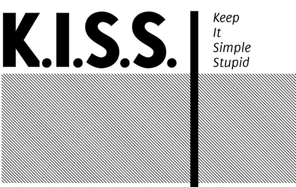Back in 2009, my colleague MG Siegler wrote a brilliant piece titled ‘Keep It Simple, Stupid,‘ which delved into how having a simple and easy to use product is a key formula for winning in the consumer tech space. A few days ago, Greylock Partner John Lilly echoed MG’s thoughts, explaining that simplicity is quite simply very hard to beat. While this doctrine has been applied to consumer technology products like Dropbox, Gmail, Twitter and most famously, Apple; reinforcing simplicity in the product thought process is becoming an ever-present part of enterprise technology as well.
Almost every pitch I receive for an enterprise product, whether it be in the business intelligence, big data, storage, or even virtualization space, includes the key phrase, “this product is extremely simple to use.” Part of this is the fact that many of these products are based in the cloud, which adds to the whole consumerization of the enterprise trend that is taking place.
But the enterprise is taking this a step further than just putting applications in the cloud when it comes to actual design and ease of use in the user experience. Take cloud storage giant Box.net, for example. The startup and its CEO Aaron Levie have been preaching simplicity in the enterprise for some time now. As Levie writes, complexity “serves as an easy – but ultimately blameless – scapegoat for failed deployments and lagging user adoption.”
Box’s drag and drop interface, which allows users to simply store and save files, avoids the complexity of many legacy options. The UI is clean, uncluttered and interestingly, Box hasn’t been in any rush to add bells and whistles to the product besides security and collaboration features. In fact much of the complexity exists behind the product, where the user doesn’t even interact.
Another area where simplicity is ruling is business intelligence. Splunk, which just filed its S-1 for an IPO, has been able to make a real business out of simplifying IT logs. Newcomer to the space, Domo, also promises a dead-simple interface for analyzing massive amounts of IT data.
Accel partner Ping Li agrees that the best enterprise applications in today’s world hide the complexity of the business processes running on the backend. He believes that while Apple has influenced consumer technology in the design and product areas, the iPhone and iPad creator is also having a big impact on the enterprise. “Steve Jobs made phones and computers easy to use, and we’re seeing the Apple-effect bring simplicity into the enterprise,’ he explains. Li points out that the iPhone and iPad are complex products when it comes to the internal hardware components but on the exterior, are incredibly simple to use.
PandoDaily’s Sarah Lacy recently wrote, there’s a new guard of entrepreneurs who are starting enterprise companies. Sarah says the ‘consumer kids’ have started creating enterprise companies, and are part of the consumerization of the enterprise. And these entrepreneurs are approaching the product for a simpler, more user-friendly point of view.
But developing these basic UIs for complex problems in the enterprise is a huge challenge. As Lilly writes, “It’s devilishly tough to build complex systems like software that actually show as simple interactions.” It’s something that Apple has mastered, and a number of enterprise companies are starting to catch on. Startups like WibiData, GoodData, and Code 42 are providing simple ways for enterprises to perform a variety of important and in-depth functions on the back-end, such as analyzing user data for personalization efforts, or developing hybrid storage solutions.
We’re also going to see more and more startups that are tackling even more complex enterprise interactions like virtualization, and creating extremely simple ways to take care of these problems.
Enterprise software is by its nature complex, but the user interface doesn’t need to be. We are all consumers of information, whether at work or at home. Any designing software needs to think about how to make it a joy to use and get people to use it repeatedly. Keep it simple, and we’ll keep coming back.
Photo credit/Flickr/bjornmeansbear
